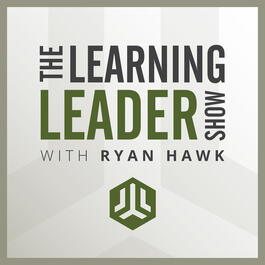
501: Paul Smith - How To Tell Stories That Inspire Change and Produce Results
Text Hawk to 66866 to become part of Mindful Monday. Join 10''s of thousands of other Learning Leaders and receive a carefully curated email from me each Monday morning to help you start your week off right... Full show notes at www.LearningLeader.com Twitter/IG: @RyanHawk12 https://twitter.com/RyanHawk12 Paul Smith is one of the world's leading experts on organizational storytelling. He's the author of multiple best-selling books including Lead with a Story (which is now in its 11th printing, and published in 7 languages around the world), Sell with a Story, and The 10 Stories Great Leaders Tell. Notes: "Decide what values you want your organization to have. Then find and capture stories that illustrate them. Remember, if you don't have strong company value stories, you probably don't have strong company values." Fill your story with surprises to pique your audience's interest and memory. Often the best way to spread a company's values and culture are through stories. Use stories to forge strong relationships between diverse team members. Stories can be used to inspire employees, even when times are tough. – You could spout nonsensical motivational phrases about "giving it 110 percent" – or you could tell an inspiring story. A successful story is comprised of only three ingredients — you need context, action, and the result (CAR). As NYU social psychologist Jonathan Haidt observes, "The human mind is a story processor, not a logic processor." Your job is to help the other person make a decision. To do that, they need to rely on both logic AND emotion. "Your first objective in a sales call should be to get buyers to tell you their stories, not the other way around." The James Watt story – Keep 1 or 2 small vital pieces of the story and save them for the end. The aha moment. The surprise makes it more memorable for your audience. Asking better questions… Instead of saying, "What keeps you up at night?" Ask… "Tell me about a moment…" You can also use this when walking home from the bus stop with your children. Instead of saying, "How was school today?" Ask, "Tell me about your day at school…" "We generally don't tell our personal stories at work because we work with strangers. They remain strangers because we don't tell our personal stories. You have to break the cycle." "Sometimes getting your employees to be more creative isn't the problem. The problem is getting their less-than-imaginative boss to give them the space to invent. Innovation isn't a linear process. Inventors need the freedom to play with ideas to see what fruit they will bear. A well-meaning boss might think he's doing his job by keeping his team focused on the most productive areas to explore. But when you insist on knowing what the fruit will be before allowing the play, many of the most revolutionary discoveries might stay undiscovered." "Many of life's failures are people who didn't realize how close they were to success when they gave up." The most effective stories play on people's emotions. – We can take an example from Texas, which in the 1980s was ridden with so-called "litterbugs." The government tried its best to combat littering by appealing to emotions, and publishing advertisements that showcased a person weeping at the sight of environmental destruction due to litter. While touching, these ads had no effect. The worst litterers were people with little concern for the environment. So, the government changed directions, What did they do? (Don't mess with Texas) Literally. The slogan was developed by the Texas Department of Transportation for an anti-littering campaign. "It's not just a prideful remark, trying to pick a fight," says Jeff Austin III, commissioner of the Texas Transportation Commission. "It's don't litter in Texas, don't mess up Texas." There are three types of learners: 40 percent of us are visual learners, 40 percent are auditory learners and the remaining 20 percent are kinetic learners. Stories attract all three – a story's imagery influences visual learners, the vocabulary appeals to auditory learners, and the emotions and feelings connect with kinetic learners.
From "The Learning Leader Show With Ryan Hawk"




Comments
Add comment Feedback